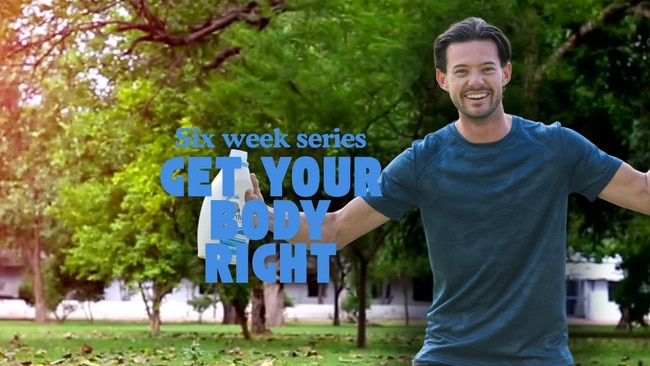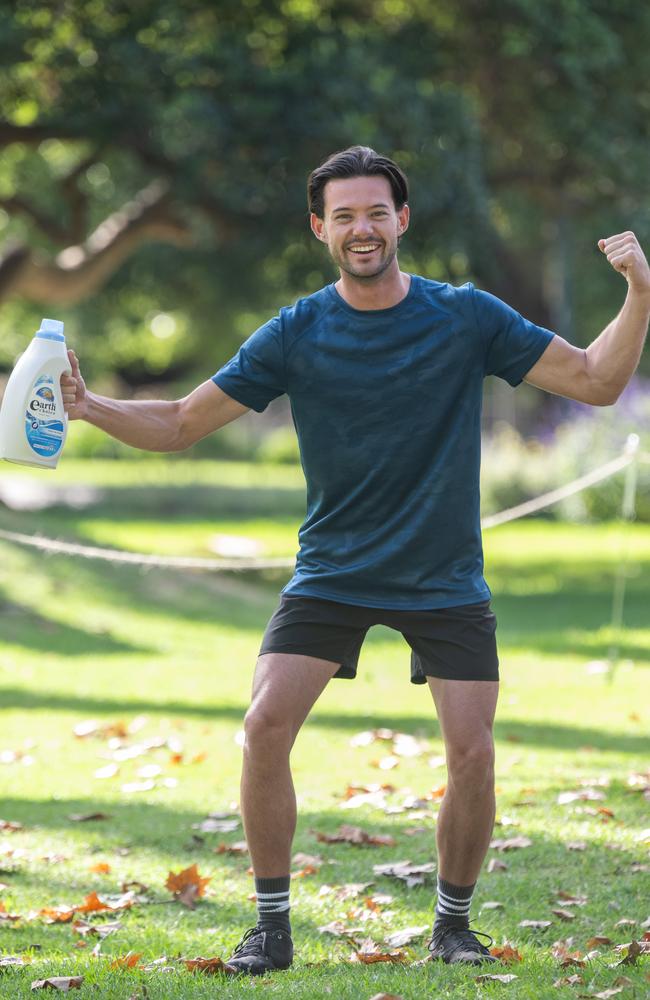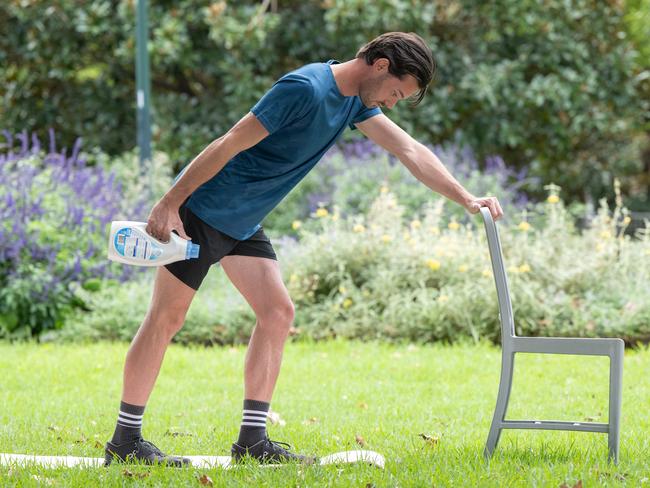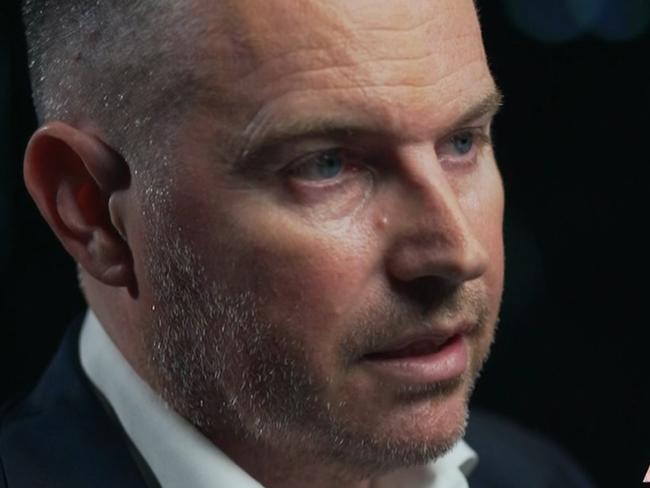Get your body right series: Do progressive overload for results
You don’t actually need to workout more often and for longer. This week of the Get Your Body Right series shows you how to make progress.

Strength Training
Don't miss out on the headlines from Strength Training. Followed categories will be added to My News.
The biggest reason people don’t see results in their workout is because they don’t know about the principle of “progressive overload”, experts say.
So in week five of the Get Your Body Right series we are introducing it with items you can find around your house, so there’s no barriers to stopping you.
You can start with a water bottle then try something heavier like a laundry bottle.
Titled Sports and Exercise Physiotherapist Chris Williams, who is part of the Australian Physiotherapy Association, said people often fell into the trap of increasing the quantity of what they were doing rather than increasing the difficulty.

“When you start to manipulate training variables such as intensity, so adding load, we would term that progressive overload,” he said.
“That’s one of the key training principles required to successfully integrate a program that’s going to create change.”
He said it not only improved function and decreased pain but would also make you look better in time.
“Often people go and exercise without adding load and they will just do more and more until the stage they will just get themselves injured or until they are sore as opposed to actually improving the capacity of the tissue so it can deal with more,” he said.
“(Progressive overload) actually helps people maintain what they like to do … but the longer you do it the more you’re going to get the extra benefits.”

This was because it made the muscle or tissue capable of doing more.
“Basically, when we’re looking to get from A to B – such as strength or improve the capacity of a muscle – we would begin with a dose, usually that dose would be a lower intensity and a higher volume,” he said.
“And as we progress forward in the program we would manipulate some of those variables and one example would be to add some load, or to increase intensity, while simultaneously, if it’s deemed necessary, take away some of the volume.
“That’s all geared towards being able to improve the capacity or create an adaptation of that muscle or that movement pattern or function in order to achieve a meaningful outcome.
Mr Williams said the biggest barrier to introducing resistance training was that people didn’t know where to start or because it was too expensive.
That’s why Kieser exercise scientist Deb Lawrence has created the program below.
Week five workout:
WALK:
Try to reach 7000 steps a day or 50 minutes of walking this week – remember cardio is also important.
PROGRESSIVE OVERLOAD EXERCISES
BEGINNER: 6 to 12 repetitions
INTERMEDIATE: 15 to 20 repetitions
ADVANCED: Go beyond until fatigued
BICEP CURLS
Start with the weight down by your side in one hand. Curl through your arm, still keeping your elbow by your side – don’t come forward with the weight, keep it tucked in as you bend it forward. Then slowly lower down.
TRICEP EXTENSION
Bend forward in a table top position with your knees slightly bent. Place one hand on a chair for support if you need. Have the arm holding the weight tucked in towards you and bent. Extend the arm out, squeezing the muscles at the back of your upper arm. It should stay tucked into your body, running parallel with your torso, while it’s straight, not beyond.
SKULL CRUSHERS
This also works your triceps. Lie on your back. Make sure the bottle’s lid is screwed on properly and your gripping it tightly so it doesn’t fall. Hold the weight up above you in both hands, arms straight. Bend your elbows, lowering the weight towards your head. Then extend up again so your arms are straight.
LATERAL RAISE
Stand with your side to a chair, which you can hold onto for stability. Have your other arm down by your side holding the weight. Slowly raise it up while straight so it is shoulder height. Then slowly lower back down.
SQUATS WITH WEIGHT
Remember this is one of the most important exercises you can do after 35 and a wall sit is an easier version, lunges harder. Hold your laundry bottle or other item close to your chest. The best way to learn to squat properly is to pretend you are sitting down on a chair, so have one there to help. Slowly bend your knees – so they are not caving in – and push your bottom back. You can slightly touch the chair. Slowly stand up.
CALF RAISES WITH WEIGHT
You can hold the weight by your side with one hand (remember to swap so it’s even) and hold the back of a chair for stability with the other. Or you can try having the weight in front of you in both hands. Like week one, stand up on your tip toes and hold. For more of a challenge, trying doing the raise with a single leg. To go even more difficult, have your feet off the edge of a step while you move onto your tip toes slowly.
Who are our experts?
Deb Lawrence is an experienced exercise scientist and sports scientist at Kieser in Melbourne. She is passionate about strength longevity, injury prevention and loves sports like futsal, hockey and soccer.
FOLLOW ALONG
Each week high-profile journalist Anthony Dowsley is following the workout plan to help him train for his upcoming trek of Machu Picchu. This is what he thought of the last instalment as he balanced covering the release of Tony Mokbel with his workout routine.

I was a youngish reporter when Tony Mokbel simply vanished in the middle of his trial in 2006.
I even got a comment from his lawyer who in turn got in trouble from the bewildered judge.
After all, the judge was annoyed he was running a trial without an accused in the dock.
I’ve never met Mokbel, but like many, I feel I know him.
After all, we do share the same name.
In the months after he skipped bail and fled to Greece via Bonnie Doon, I caught up with his then girlfriend, Danielle McGuire.
She ran a hair salon in South Yarra and, as we sat on the floor in a storage room, she told me that although she didn’t know where Mokbel was, it was better he be free than trapped in a cage.
What I didn’t know is she had been visiting him on the sly and was pregnant with a girl - Renate.
Back then, he was dubbed Fat Tony.
I, on the other hand, was fit.
But no one called me Thin Tony.
When news leaked that Mokbel was captured in Athens 15 months later, I called a top cop, Simon Overland.
He wasn’t chatty and feigned not to be aware of this significant development.
Our lives would all intersect later because of the Lawyer X story - the revelation that Overland had overseen the turning of Mokbel’s lawyer, Nicola Gobbo, into an informer against him.
When I set eyes on Mokbel for the first time in the flesh as he walked away from court a free man on Friday, I couldn’t help a thought flashing through my mind.
Tony has lost 20kg, and I’ve put them on.
Am I now Fat Tony?
Extra weight has many negatives.
One of them is bad posture and the unrelenting ache I feel down the side of my neck.
They now call it “tech neck”.
Checking blindspots in the car is now a pain.
I figure it’s a result of the years I’ve spent hunched over a desk and staring down at my phone.
So this week was a game changer.
In last week’s fourth instalment of the Get Your Body Right Series, I’ve been concentrating on dulling those aches by completing the neck stretches, leg cycling, the glute bridge and the “superman” pose.
It instantly makes you stand straighter. But I’m still working on my Underbelly.





